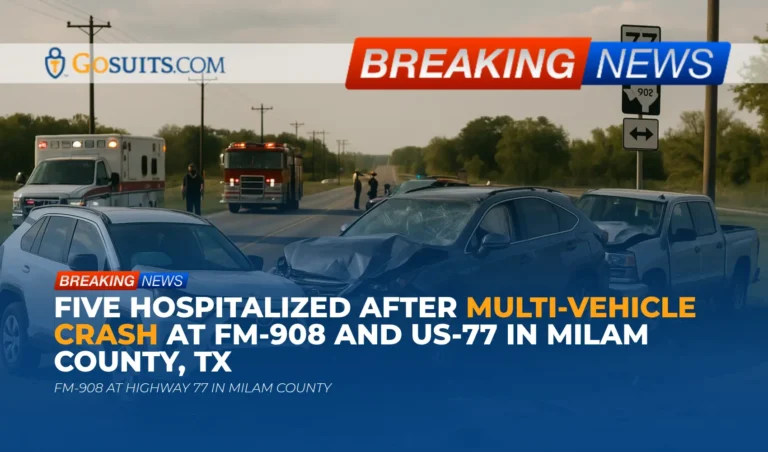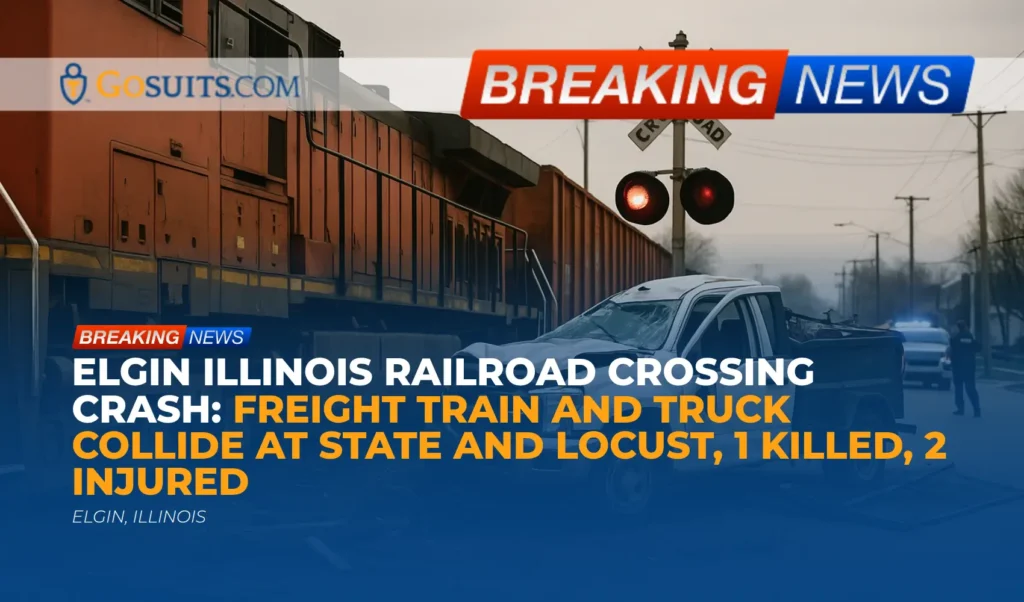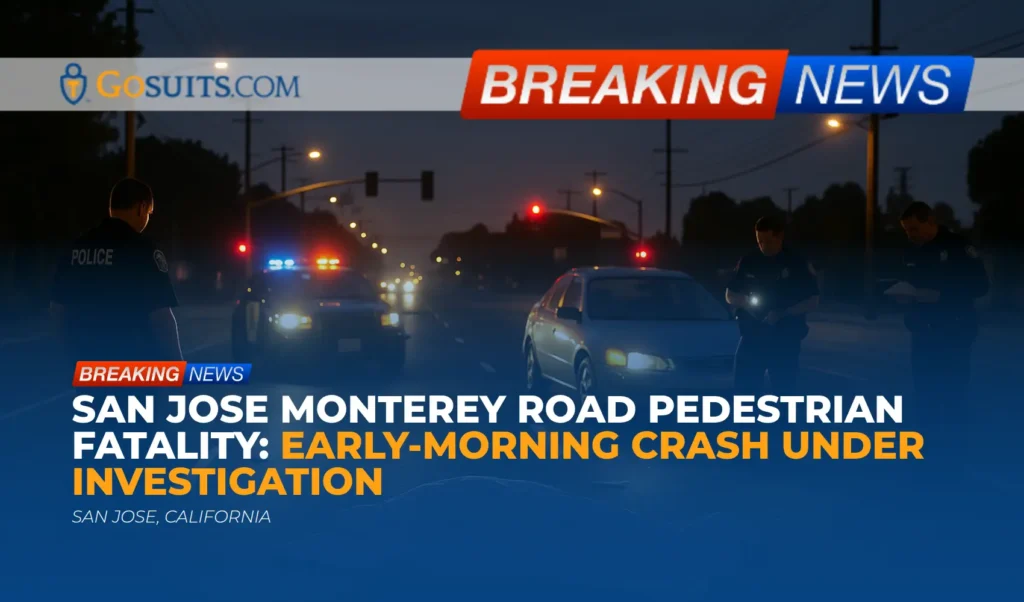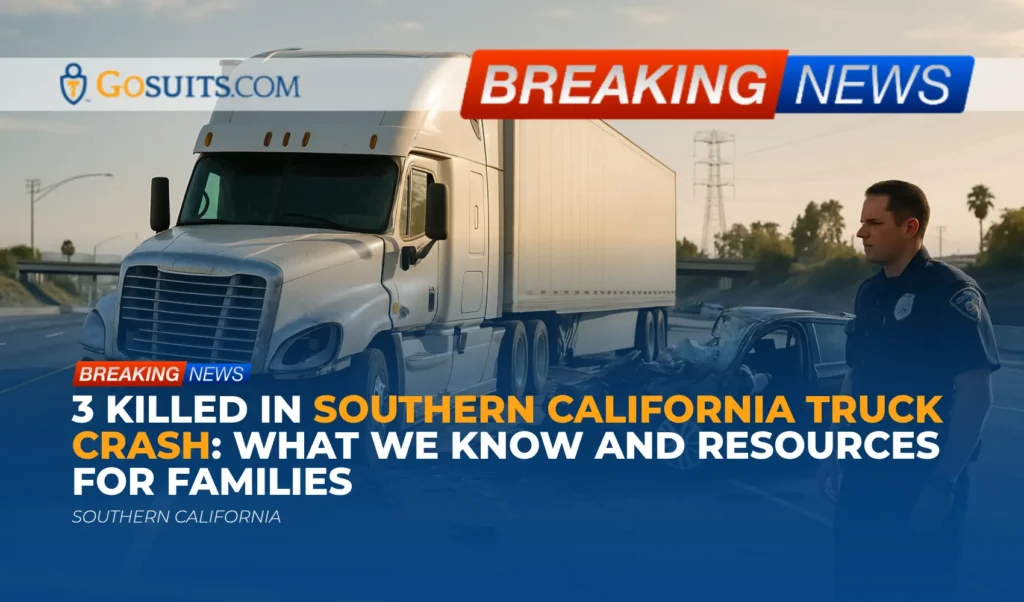- Incident overview and what is known so far
- Location context: FM-908 at Highway 77 in Milam County
- Reported injuries and emergency response
- Why multi-vehicle intersection crashes occur
- Potential civil liability considerations in Texas crashes
- Evidence that often matters after a serious crash
- How to obtain official records and information
- Insurance and claims guidance after a severe collision
- Key Texas timelines and deadlines that may apply
- Community safety notes to reduce future harm
- Commentary from Gosuits Milam County, Texas Personal Injury Attorney
- How to take thoughtful next steps today
Incident overview and what is known so far
Five people were hospitalized after a multi-vehicle crash on Tuesday afternoon in Milam County, Texas. According to information attributed to the Texas Department of Public Safety, the collision occurred around 3:30 p.m. at the intersection of FM-908 and U.S. Highway 77. A 2025 Toyota RAV4 driven by a 32-year-old man from Fremont, California, was traveling westbound on FM-908 when it collided with a northbound 2012 Lexus SUV driven by a 45-year-old woman from Frisco, Texas. The initial impact caused the Lexus to enter the southbound lanes of Highway 77, where it then collided with a 2022 Chevrolet Silverado driven by a 51-year-old Milano, Texas resident. Investigators reported serious injuries among the occupants of the Toyota and Lexus, as well as the Chevrolet driver. Additional details have not yet been released, and the investigation remains ongoing.
At this stage, there is no public confirmation of specific causes or traffic control details, and no finding of fault has been announced. When information is limited, it is common for authorities to continue collecting statements, roadway measurements, and vehicle data before releasing further updates.
Location context: FM-908 at Highway 77 in Milam County
FM-908 is a farm-to-market roadway that connects local communities to larger regional corridors. U.S. Highway 77 is a major north-south route that carries both local and through traffic. Intersections where a lower-speed local road meets a higher-speed highway can pose heightened risks, particularly where traffic volumes vary by time of day, sight lines change near curves or grades, or drivers misjudge gaps in oncoming traffic. Rural highways also tend to experience severe injury crashes due to speed limits and the forces involved in multi-vehicle impacts.
Federal safety agencies note that rural and high-speed corridors often see higher fatal and serious-injury crash rates relative to urban streets, largely due to speed, roadway geometry, and distance from trauma care. The Federal Highway Administration provides safety strategies for intersections and rural roads to mitigate these risks, including visibility improvements, advance warning, and intersection reconfiguration where warranted. See the Federal Highway Administration’s resources on intersection safety and rural road safety for context about why these locations demand extra caution (FHWA Intersection Safety) and (FHWA Rural Safety).
Reported injuries and emergency response
Officials indicated that the Toyota driver and a 27-year-old passenger, as well as the Lexus driver and a 70-year-old passenger, were transported for serious injuries. The Chevrolet driver was also hospitalized with serious injuries. The severity of injuries described underscores the violence of multi-vehicle impacts, especially when a vehicle is redirected into another travel lane after the first collision.
Emergency response in rural counties typically involves local law enforcement, fire and EMS, and in some cases air medical transport if injury severity and distance to a trauma center make that necessary. While no detailed EMS information was publicly included in the initial report, serious injuries often lead first responders to secure the scene, triage patients, and coordinate with hospitals to receive multiple injured parties at once. The National Highway Traffic Safety Administration works with states and communities on injury prevention measures such as seat belt use and proper child restraint systems, which remain among the most effective ways to reduce injury severity in crashes (NHTSA Seat Belts).
Why multi-vehicle intersection crashes occur
Intersection crashes can be complex, involving multiple vehicles, angles of impact, sight distance limitations, and driver decision-making under time pressure. While the specific cause of this crash has not been released, national research highlights recurring factors:
- Decision errors at intersections such as misjudging another vehicle’s speed or gap, false assumption of the other driver’s actions, or inattention during a turning or crossing movement.
- Limited sight distance near curves, grades, or visual obstructions that shorten the time available to perceive and react to cross-traffic.
- Speed differentials between local roads and higher-speed highways, which increase the severity of impact when collisions occur.
- Complex traffic control and multiple conflict points that require careful gap selection and adherence to right-of-way rules.
NHTSA has studied the role of driver performance and roadway context in intersection-related crashes. Their analyses describe how recognition errors, decision errors, and performance errors contribute to these events (NHTSA Crash Factors in Intersection-Related Crashes). The Federal Highway Administration similarly urges engineering, enforcement, and education strategies that address both human behavior and road design (FHWA Intersection Safety).
Potential civil liability considerations in Texas crashes
In Texas, civil responsibility for a crash is generally governed by negligence principles and proportionate responsibility. More than one party can share fault, and each may be responsible for a percentage of damages that corresponds to their share of responsibility.
- Proportionate responsibility. Under Texas law, a person may recover damages only if they are not more than 50 percent responsible for their own injuries. If they are 51 percent or more responsible, they are barred from recovery against others. See Texas Civil Practice and Remedies Code Chapter 33, including Section 33.001 (Texas CPRC 33.001).
- Right-of-way and turning rules. Traffic statutes establish duties related to intersections, including yielding at stop or yield signs, safely turning left, and entering highways only when movement can be made with safety. See Texas Transportation Code Sections 545.151 and 545.152 (Sec. 545.151) and (Sec. 545.152).
- Multiple-collision sequences. When an initial impact sends a vehicle into another lane, a second collision can occur. Investigations often assess each driver’s actions leading up to each impact, roadway design, signage, and any mechanical defects.
- Commercial or governmental actors. If a commercial vehicle or a governmental entity is involved, different rules can apply, including special notice requirements for claims against governmental units. See Texas Civil Practice and Remedies Code 101.101 (Texas Tort Claims Act notice).
An experienced evaluation typically examines driver conduct, compliance with traffic control, dash or surveillance video, vehicle data, roadway conditions, and whether any third party contributed to creating a hazardous condition.
Evidence that often matters after a serious crash
Preserving evidence early can be critical in understanding what happened and protecting the rights of those affected. The following items often prove important:
- Official crash report. The report created by the investigating officer includes diagrams, initial observations, and contributing factors as assessed at the scene, along with contact information for involved parties and witnesses. Access to reports in Texas is governed by statute and is usually available to involved parties and their representatives.
- Event Data Recorder information. Many late-model vehicles store pre-crash and crash data, such as speed, throttle position, braking, and seat belt status. NHTSA provides information regarding event data recorders and their role in crash analysis (NHTSA on EDRs). Preserving the vehicle and arranging a proper download can be crucial.
- Scene documentation. Photos or video of vehicle resting positions, skid or yaw marks, debris fields, and damage patterns can help reconstruct the sequence of impacts. Prompt documentation is helpful because weather and traffic can alter evidence quickly.
- Witness statements. Independent witnesses can provide valuable third-party observations about speeds, signals, and vehicle movements.
- Medical records. Hospital and treating provider records document injuries, diagnostics, treatment plans, and prognosis. Individuals have a federal right to access their medical records under the HIPAA right of access rules from the U.S. Department of Health and Human Services (HHS Right of Access).
- Traffic signal timing and roadway records. Where relevant, obtaining signal timing sheets, sign inventories, or construction records from the appropriate agency may shed light on operational conditions at the time of the crash.
How to obtain official records and information
Depending on the nature of the crash and the agencies involved, these are common sources of reliable records in Texas:
Crash report and related records
- Texas crash reports. Access to Texas peace officer crash reports and related records is governed by Texas Transportation Code Section 550.065. Involved parties, their insurers, and certain others may obtain a copy under that statute. See the statute for eligibility and confidentiality provisions (Transportation Code 550.065).
- Requesting the report. Crash reports for Texas highways can typically be obtained through the statewide crash records system administered by the Texas Department of Transportation. TxDOT provides public-facing information about crash reports and records on its official website (TxDOT). If a local department investigated, that agency may also advise on how to obtain the report.
- Supplemental materials. Photographs, diagrams, body-worn camera video, and 911 audio may be subject to the Texas Public Information Act, with exceptions for sensitive information. The Texas Office of the Attorney General offers guidance on making requests as a member of the public (Texas OAG Open Government).

Medical and hospital records
- Patient right of access. Patients and authorized representatives can request copies of medical records directly from the hospital or provider. The federal right of access is described by HHS and generally requires providers to furnish records within a set time frame, subject to limited fees and exceptions (HHS Right of Access).
If a death occurs
- Inquest and autopsy. In Texas, deaths resulting from accidents may be subject to an inquest by a justice of the peace or a medical examiner depending on the county. The process and authority for inquests and autopsies are set out in the Texas Code of Criminal Procedure, Chapter 49 (CCP Chapter 49).
- Death certificates. Certified copies of death certificates are available through the Texas Department of State Health Services Vital Statistics section. Eligibility rules apply, and DSHS explains how to request vital records (Texas DSHS Vital Statistics).
Traffic operations and roadway records
- Signal timing, signage, construction logs. Depending on jurisdiction, TxDOT or a city or county may maintain records related to signals, signs, and construction near the crash site. Requests can be made through the appropriate agency’s public information portal. Start with the TxDOT website for state-maintained roadways (TxDOT) and the Texas Attorney General’s Open Government portal for public information request guidance (Texas OAG Open Government).
Insurance and claims guidance after a severe collision
Insurance issues after a multi-vehicle crash can be complicated, especially when there are multiple impacts and injuries. The order of impacts, points of rest, and the governing traffic rules will influence how insurers allocate fault and coverage. A prudent first step is to consult an attorney before speaking with any insurance adjuster about the facts or providing a recorded statement. What is said to an insurer can be used later and may affect how fault is assigned and how claims are evaluated.
- Liability coverage. Texas requires drivers to maintain minimum liability coverage limits. The Texas Department of Insurance provides consumer information about required coverages and how liability claims work (Texas Department of Insurance).
- Personal Injury Protection or Medical Payments. PIP is offered in Texas and provides certain medical and lost-income benefits regardless of fault unless it is rejected in writing. MedPay is an optional coverage for medical expenses. The Texas Department of Insurance offers consumer guidance on these coverages (Texas Department of Insurance).
- Uninsured and Underinsured Motorist coverage. UM and UIM can be crucial when another driver has inadequate insurance. Texas insurers must offer UM/UIM, and drivers must reject it in writing if they do not want it. See consumer resources from the Department of Insurance (Texas Department of Insurance).
- Property damage claims. Vehicle damage claims often involve separate adjusters and separate timelines. Preserving the vehicle until it can be inspected and any EDR data can be downloaded is important before authorizing repairs or total loss disposal.
- Recorded statements and authorizations. Consider declining recorded statements and broad medical authorizations until after obtaining legal counsel. Insurers may seek statements early, but the full picture of injuries often emerges over weeks or months.
When multiple vehicles are involved, each insurer may reach different conclusions about fault. Early scene evidence, objective data from vehicles, and measured roadway marks tend to carry more weight than recollections alone.
Key Texas timelines and deadlines that may apply
Deadlines in Texas civil matters can be strict. Missing them can affect the ability to bring a claim. The time periods below are general statutes and do not cover every situation:
- Personal injury claims. In many cases, the limitations period for personal injury in Texas is two years from the date of the incident. See Texas Civil Practice and Remedies Code Section 16.003 (CPRC 16.003).
- Wrongful death claims. Texas law generally provides a two-year period for wrongful death claims, measured from the date of death, subject to certain exceptions. See CPRC Section 16.003 (CPRC 16.003).
- Claims against governmental entities. Notice requirements can be much shorter. The Texas Tort Claims Act requires notice within six months for many claims, and some local governments have even shorter notice periods. See Texas Civil Practice and Remedies Code Section 101.101 (CPRC 101.101).
Because limitations and notice rules are nuanced and may be affected by various factors, timely consultation with a qualified attorney can help ensure the correct deadlines are identified and met.
Community safety notes to reduce future harm
Although no public determination of cause has been released for this crash, there are broad lessons that can help reduce the likelihood and severity of intersection collisions:
- Approach intersections deliberately. Slow down, scan for cross-traffic, and confirm that oncoming vehicles are slowing or stopped. National research has associated many intersection crashes with recognition and decision errors (NHTSA).
- Mind speed differentials. When turning onto or crossing a higher-speed highway, allow more time and distance than you might on a slower urban street. High closing speeds leave less margin for error.
- Protect children and older adults. Ensure correct child restraint installation and consider seating positions that maximize protection. Older adults may be more vulnerable to injury from the same collision forces.
- Always wear seat belts. Seat belts remain one of the most effective protections against severe injury. NHTSA provides ongoing research and guidance on seat belt effectiveness and usage (NHTSA Seat Belts).
Roadway safety is shared by everyone: drivers, designers, and policymakers. FHWA’s intersection and rural safety programs outline proven strategies communities can use to reduce crash risk (FHWA Intersection Safety) and (FHWA Rural Safety).

Commentary from Gosuits Milam County, Texas Personal Injury Attorney
Our thoughts are with every person injured in this serious crash at FM-908 and Highway 77, and with their families who are supporting them through treatment and recovery. This article is intended for educational purposes and general information for the community as official investigations continue.
Based on what has been publicly shared, this incident appears to involve an initial collision that redirected a vehicle into opposing lanes, a scenario that often results in multiple impacts and severe injuries. In multi-vehicle intersection crashes, determining how and why the first impact occurred, whether each driver had the right-of-way, and whether there were visibility or timing factors, is essential. Objective sources such as skid measurements, vehicle event data, and independent witness accounts frequently become central to understanding responsibility.
Insurance companies and large corporations often move quickly after a high-injury crash. Adjusters may request recorded statements, broad medical authorizations, or an early settlement before the full extent of injuries is understood. These are common strategies that take advantage of the stress and uncertainty people feel in the days after a collision. Early statements can be used to shape liability decisions, and early offers may not reflect long-term medical needs, time away from work, or future care. A careful, step-by-step approach helps level the playing field.
Free consultations are an important opportunity to understand rights and options without financial pressure. Speaking with a seasoned personal injury attorney before engaging with insurers can help avoid missteps, preserve key evidence, and clarify timelines that might affect a claim. Each case has unique facts, and evaluating them promptly can make a meaningful difference in outcome and peace of mind.
How to take thoughtful next steps today
- Prioritize medical care and documentation. Seek appropriate evaluation and follow recommended treatment. Keep copies of discharge summaries, imaging reports, prescriptions, and billing statements. Consistent medical documentation helps connect injuries to the collision and guides decisions about work, rehabilitation, and future care.
- Preserve vehicles and electronic data. Before authorizing repairs or total loss disposal, ensure vehicles are preserved for inspection and event data recorder downloads. Once altered or crushed, valuable evidence can be lost.
- Secure scene evidence quickly. Collect and organize photographs of vehicles, the crash location, roadway markings, and any visible injuries. Note the weather, lighting, and any nearby cameras that might have captured video. Time is critical because physical evidence can fade or be removed.
- Request official records methodically. Determine which agency investigated and request the crash report when available under Texas Transportation Code 550.065. Consider public information requests for 911 audio, CAD logs, and relevant photos or video through the open government process. Follow agency instructions and preserve receipts and correspondence.
- Be cautious with insurance communications. Before opening a claim or giving a recorded statement, consult an attorney to understand rights and obligations. Statements to insurers can be used later, and early evaluations may not reflect the full scope of injury and loss.
- Track costs and impacts. Keep a simple log of missed work, out-of-pocket expenses, mileage to medical appointments, and daily limitations. This contemporaneous record helps capture how the collision has affected day-to-day life.
- Understand time sensitivity. Texas law includes important deadlines, such as the general two-year limitations period for many injury claims and shorter notice requirements for governmental entities. Acting promptly allows time to preserve evidence, consult qualified counsel, and meet all applicable timeframes.
- Consider a free consultation. Speaking with a skilled injury attorney at no initial cost can clarify potential claims, insurance coverages, and next steps. Early guidance helps avoid common pitfalls and ensures that critical evidence is identified and protected before it disappears.
Taking these steps sooner rather than later can preserve options. Evidence is most reliable near in time to the crash, vehicles are more readily accessed before they are moved or disposed of, and witnesses are easier to locate while memories remain fresh. Prompt, organized action helps set the foundation for whatever path forward is appropriate.






